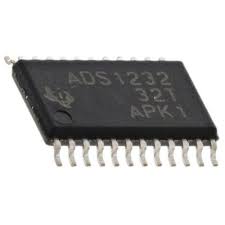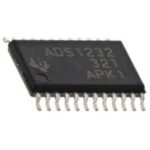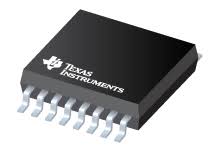ADS1232IPWR -24-Bit, Delta-Sigma ADCs for Bridge Sensors
₹650.00
ADS1232IPWR is 24-bit precision analog-to-digital converter (ADCs). The ADS123x provides a full front-end solution for bridge sensor applications such as weigh scales, strain gauges, and pressure sensors thanks to its low-noise programmable gain amplifier (PGA), precision delta-sigma ADC, and internal oscillator. A differential input multiplexer (MUX) can receive two (ADS1232) or four (ADS1234) differential inputs. The ADS1232 also has a temperature sensor to monitor the outside temperature. The low-noise PGA supports a full scale differential input of 2.5 V, 1.25 V, 39 mV, or 19.5 mV and has a selectable gain of 1, 2, 64, or 128. The delta-sigma ADC has a maximum effective resolution of 23.5 bits and two data rates: 10 SPS (with 50-Hz and 60-Hz rejection) and 80 SPS.? directly connected to the MSP430 and other microcontrollers.
ADS1232IPWR -24-Bit, Delta-Sigma ADCs for Bridge Sensors – ADS1232 and ADS1234 (ADS123x) are precision, 24-bit, analog-to-digital converters (ADCs). With a low-noise programmable gain amplifier (PGA), a precision delta-sigma ADC, and an internal oscillator, the ADS123x provides a complete front-end solution for bridge sensor applications including weigh scales, strain gauges, and pressure sensors.
An input multiplexer (MUX) accepts either two (ADS1232) or four (ADS1234) differential inputs. The ADS1232 also includes a temperature sensor to monitor the ambient temperature. The low-noise PGA has a selectable gain of 1, 2, 64, or 128, supporting a full-scale differential input of ?2.5 V, ?1.25 V, ?39 mV, or ?19.5 mV.
The delta-sigma ADC provides a maximum of 23.5-bits effective resolution and supports two data rates: 10 SPS (providing 50-Hz and 60-Hz rejection) and 80 SPS. The ADS123x can be clocked externally using an oscillator or a crystal, or by the internal oscillator.
Offset calibration is performed on-demand, and the ADS123x can be put in a low-power standby mode or shut off completely in power-down mode. The ADS123x is operated through simple pin-driven control?there are no digital registers to program.
Data are output over a two-wire serial interface that connects directly to the MSP430 and other microcontrollers.
ADS1232IPWR – Features
- Complete front-end for bridge sensors
- 23.5-bits effective resolution at gain = 1
- 19.2-bits noise-free resolution at gain = 64
- Low-noise PGA
- Selectable gains of 1, 2, 64, and 128
- RMS noise:
- 17 nV at 10 SPS at gain = 128
- 44 nV at 80 SPS at gain = 128
- 100-dB simultaneous 50-Hz and 60-Hz rejection
- Flexible clocking:
- Low-drift internal oscillator
- Optional external crystal
- Selectable 10-SPS or 80-SPS data rates
- Easy ratiometric measurements:
- External voltage reference up to 5 V
- Two-channel differential input with an internal temperature sensor (ADS1232)
- Four-channel differential input (ADS1234)
- Two-wire serial interface
- Supply voltage range: 2.7 V to 5.3 V
- Temperature range: ?40?C to 105?C
- Packages: TSSOP-24 (ADS1232) or TSSOP-28 (ADS1234)


MAECENAS IACULIS
Vestibulum curae torquent diam diam commodo parturient penatibus nunc dui adipiscing convallis bulum parturient suspendisse parturient a.Parturient in parturient scelerisque nibh lectus quam a natoque adipiscing a vestibulum hendrerit et pharetra fames nunc natoque dui.
ADIPISCING CONVALLIS BULUM
- Vestibulum penatibus nunc dui adipiscing convallis bulum parturient suspendisse.
- Abitur parturient praesent lectus quam a natoque adipiscing a vestibulum hendre.
- Diam parturient dictumst parturient scelerisque nibh lectus.
Scelerisque adipiscing bibendum sem vestibulum et in a a a purus lectus faucibus lobortis tincidunt purus lectus nisl class eros.Condimentum a et ullamcorper dictumst mus et tristique elementum nam inceptos hac parturient scelerisque vestibulum amet elit ut volutpat.
Related products
ADC0804 8-Bit Analog to Digital A/D Converter IC DIP-20 Package
ADC0809 8-Bit A/D Converter with 8-Channel Multiplexer IC DIP-28 Package
ADS1230IPWR – 20 Bit Analog to Digital Converter For Bridge Sensors
ADS1230IPWR - 20-Bit, 80SPS, 1-Ch Delta-Sigma ADC for Resistive Bridge Sensors & Weigh Scales
The ADS1230 is a 20-bit precision analog-to-digital converter (ADC). The ADS1230 provides a full front-end system for bridge application areas such as weigh scales, strain gauges, and pressure sensors thanks to an inbuilt low-noise programmable gain amplifier (PGA), onboard oscillator, and precision 20-bit delta-sigma ADC. The low-noise PGA has a gain of 64 or 128, allowing for a full-scale differential input of 39mV or 19.5mV. The delta-sigma ADC has an effective resolution of 20 bits and is made up of a 3rd order modulator and a 4th order digital filter. APPLICATIONS- Weigh Scales
- Strain Gauges
- Pressure Sensors
- Industrial Process Control




















Reviews
There are no reviews yet.